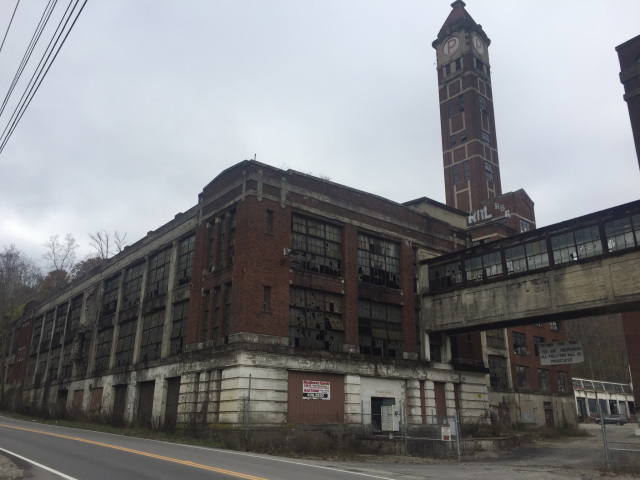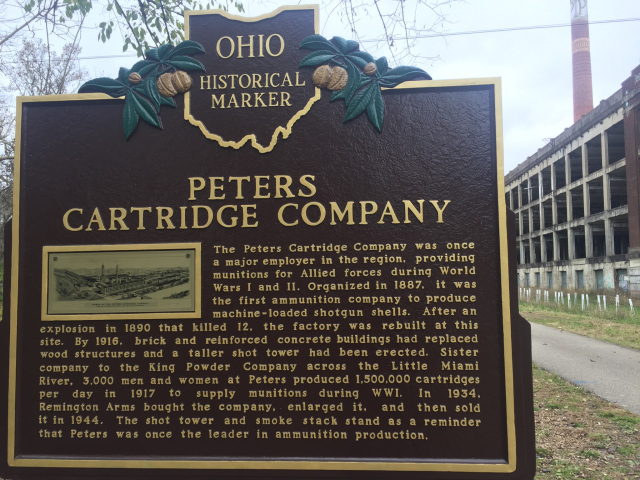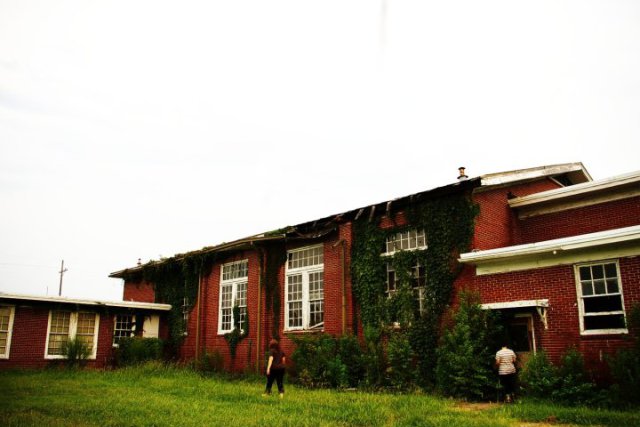Ever since my family moved to Warren County about 15 years ago, the Peters Cartridge Company’s husk loomed over the horizon. It’s only about a five minute drive from the house I grew up in. A winding road will lead you past it place next to the Little Miami Bike Trail, where it goads cyclists with its mysterious presence. Its appearance was never the most frightening thing about it, as there are plenty of creepy stories. Peters Cartridge Company is known for the explosion which took place over 100 years ago, killing a dozen people. Although that’s the most famous story, I was able to find a few other examples of explosions happening at the factory. Due to the manufacturing that took place, a poisonous mixture of copper, lead and mercury seeped out into the soil. In fact, the damage was so bad it can be found on the EPA’s Superfund National Priorities List. Such a phenomenon gives me the Tolkenian imagery of evil spreading into the land around Mt. Doom, turning surrounding vegetation into blackened husks. Like Mordor, the Peters Cartridge Company always seemed like a “dying land not yet dead.” I’d also heard stories of Satanic cults taking up residence in the building, although this has been shown to just have been some silly vandals trying to frighten kids like me. Going back now, the place seems a little less frightening. Much of the site’s toxic soil has been cleaned and countless saplings line the bike trail which passes by the factory. Although there are plenty of no trespassing signs, cars can be occasionally be seen leaving and entering the premises.

The Peters Cartridge Company greets drivers and bikers passing through Kings Mills.
From the first time I saw the factory, I’d always had an urge to see what’s inside. Many share this urge not just for Peters Cartridge Company, but abandoned buildings all over the world. Why do people seek out these places which give us signals to keep out? What is it about ruins which makes people want to return? Is it the sense of danger which could give one an adrenaline rush, or something more tame such as historical appreciation?
Many people enjoy the concept of mystery — trying to piece together threads to create a bigger picture — and nothing is as mysterious as a slumbering amalgamation of steel, concrete and glass. It’s tough not to see an old building without any human activity and wonder as to why people left and why no one has returned. Whenever I pass by that forgotten factory, I’m always looking in the windows, searching for a face or figure which would ease my sense of mystery. Of course, I never see anything. Those who enter these places seem to have the will to move past this sense of wonder about a place and grasp at the ambition to find out what’s going on inside. That, however, requires overcoming fear, especially if such a place is off limits not just within one’s own mind, but by society’s rules. Aside from the dangers of structurally unsound buildings with broken glass, rust and possibly toxic substances, the danger of law enforcement exists when one is trespassing while exploring. “We live our whole lives as prisoners of artificial boundaries — boundaries put in place not by mountains, rivers, or walls but by people and institutions who simply tell us that they’re there,” writes Moses Gates in his urban exploration memoir Hidden Cities. I can imagine the adrenaline rush one gets from the possibility of danger can make sneaking into places most don’t go all the more enjoyable.

This marker can be found on the bike trail which runs by the abandoned factory.
The fear of bodily harm was palpable when was thinking of exploring an abandoned mining complex in Mineville, New York. I had gone over the summer to visit a friend and we learned about the iron mining operation which was happening there about 100 years ago. It was possible to still see some of the remnants of the mining and we talked about trying to check it out. Even before we started driving around to look for the mine, I had cultivated a fear of falling down a mine shaft. I imagined myself tumbling down and being horribly injured but still alive, much like the gruesome scene in Native Son when Bigger Thomas throws his girlfriend, Bessie, down the air shaft of an abandoned building. Such fear is something I wish I could overcome, but it becomes so difficult once it latches itself to my mind.
To overcome these fears is to allow oneself access to places unlike anything seen in everyday life. When a building is abandoned, it takes on a new life as wildlife and rust overtake its form, turning it into something new. I find it interesting how nature can reclaim a man-made structure, something which can be seen at great length in Chernobyl, an entire city abandoned after a nuclear meltdown occurred.
Many of those who explore abandoned places also seem to be driven by an interest in history. Abandoned buildings could indeed offer a unfettered look at the past, especially if artifacts such as documents and machines are left behind. While reading a piece from SFGate about urban exploration, I came across an interesting passage in which the explorers discouraged taking items as a means of preserving the site for others. There are no official rules for preservation, simply an unspoken understanding, it seems. “For many urban explorers … these sites are not trash heaps but historic landmarks,” James Nestor writes in the article.
In this sense, urban explorers seem like historians in a way, seeking to keep remnants of the past alive when most forget them. Finding such artifacts surely gives explorers a feeling of discovery. There is surely a sense of fulfillment in being able to introduce one’s self to these American ruins. While our ruins may have more rust and less crumbling stone than the rest of the world’s, they still bring us an understanding of our own history and what life used to be like. “Their ruination is an ongoing, unmanaged process, and this makes them all the more satisfying to the melancholic imagination, which yearns for the intermediate moment,” writes Frances Stonor Saunders for The Guardian.
My friend, Amanda Winters, the very person I considered exploring the abandoned mine in New York with, also appreciates the historical significance of places she explores. Before even considering exploring the mine and an abandoned theme park, we dug into the area’s history both by reading online and visiting the area’s history museum.
That same curiosity was piqued during her most memorable urban exploration endeavor. She and a few others had happened by an abandoned elementary in Transylvania, Louisiana. The spooky name in addition to the dilapidated exterior made them want to see what was inside.
“We went in and a lot of things were still left in there,” she said. “I don’t know why they left all the stuff in there.”
Among some of the items they found were microscopes, topographical maps and mannequins used to teach human biology.

The abandoned elementary in Transylvania, Louisiana. Photo courtesy of Amanda.
Amanda was left wondering why people would abandon such a building and why they would leave everything behind. The mystery was left open, as she was never able to find details online about the school. Fortunately, she directed me to something which had been written on the place since then. It seems people are seeking to give it new life, though I haven’t found any reason as to why it fell into disuse in the first place.
Characteristically of an elementary school, there wasn’t much danger to found. However, as she and her friends were leaving, they spotted an ominous sign in the grounds outside.
“As we were headed out, we saw a man’s footprint, like a big boot,” she said. “It was fresh but we didn’t hear anyone in there.”
Being able to see such a footprint and still have the spirit of urban exploration lit in one’s chest is a hurdle I still must leap.
Advertisements Share this:




